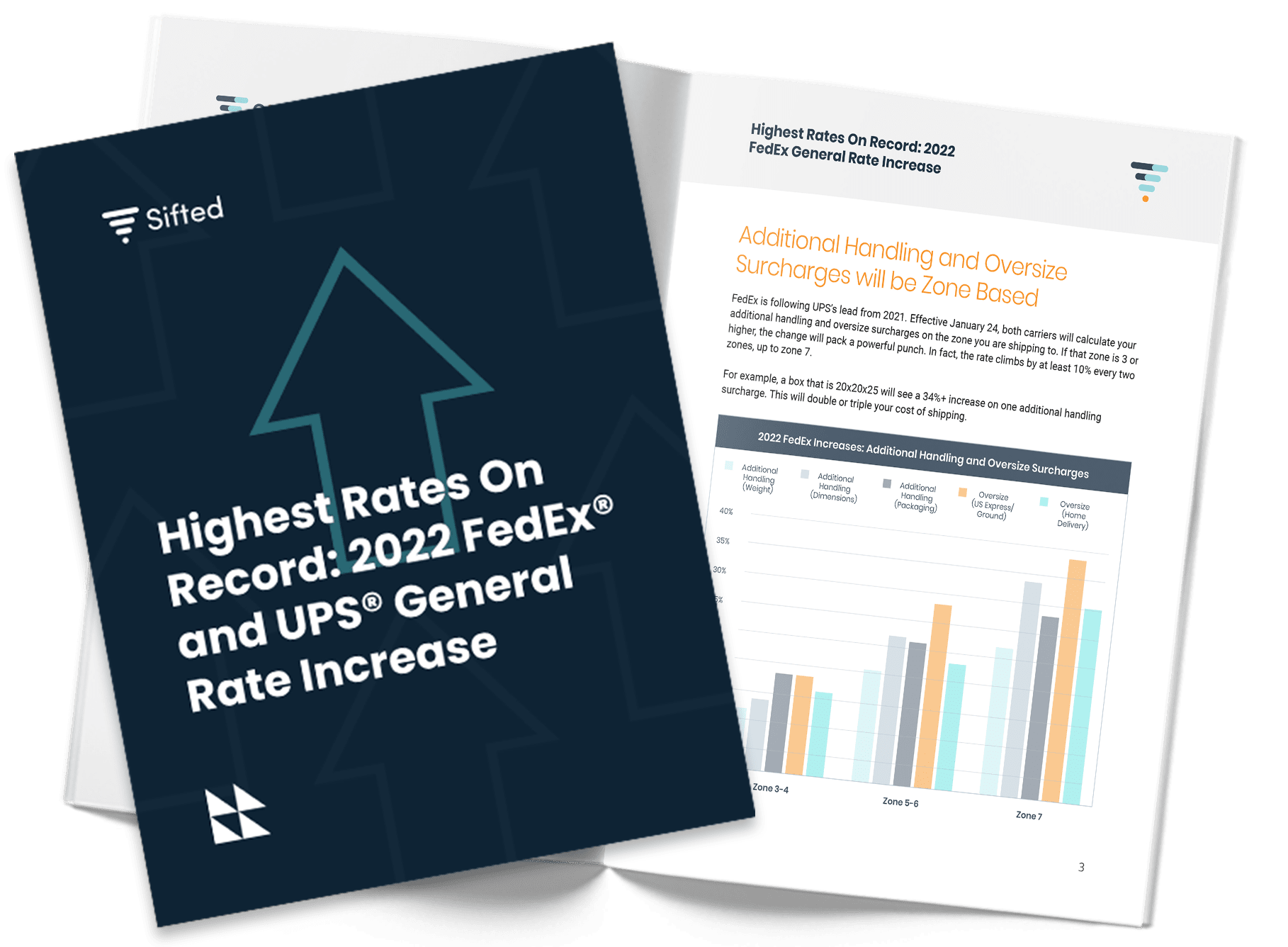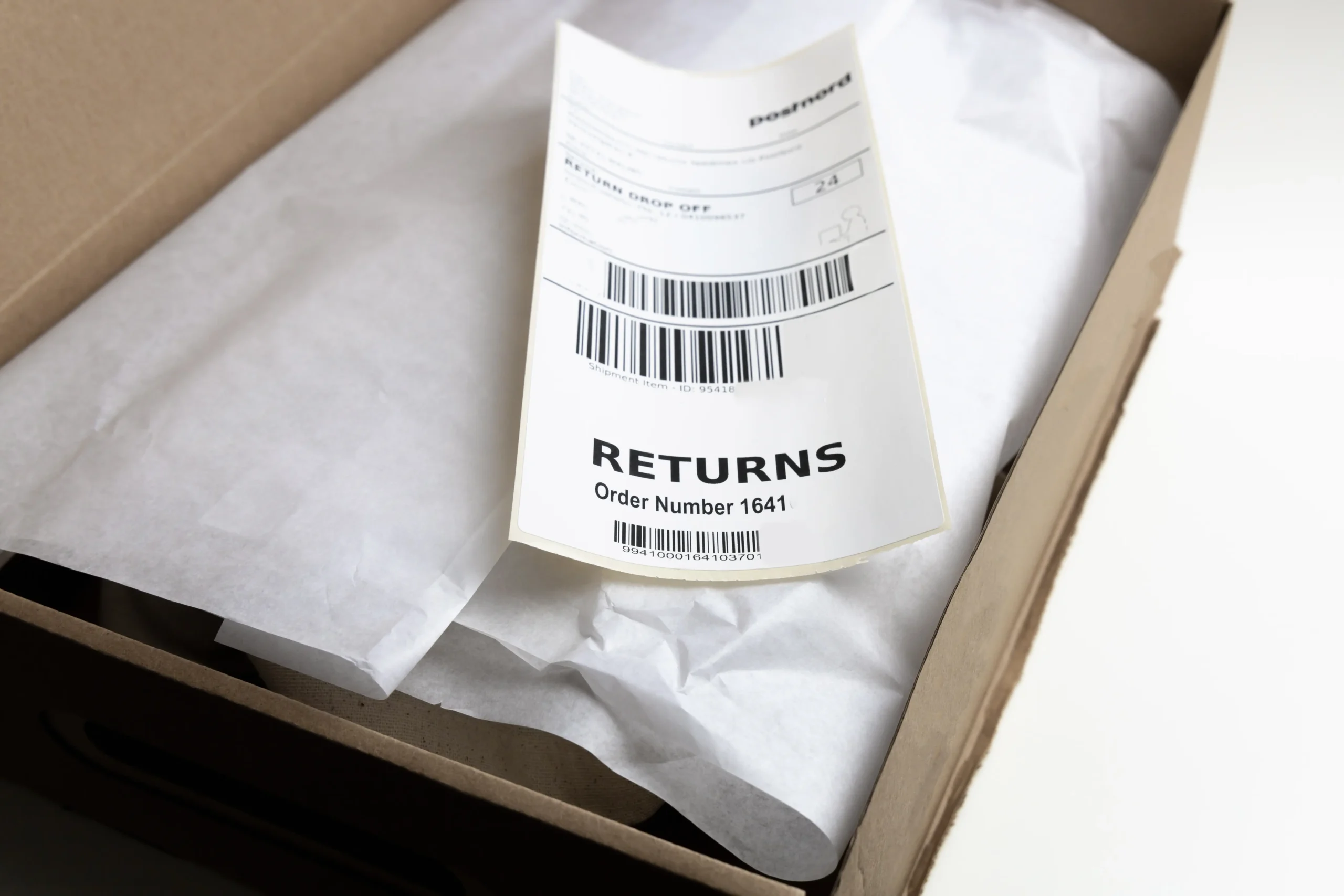What are carrier surcharges?
A carrier surcharge is an additional charge on top of the base shipping rates to cover the costs of extra expenses involved in fuel price fluctuations, special packaging, or other expenses.
eCommerce sales in the U.S. grew from $431.6 billion in 2020 to $469.2 billion in 2021. Although this increase is good news for online sellers, new shipping costs such as carrier surcharges are eating into some of that revenue.
Shipping surcharges are often one-time and short-term fees, but they quickly add up to deplete your bottom line. Understanding these hidden charges is vital to ensuring the profitability of your business. This knowledge also helps you minimize carrier surcharges that your business incurs.
Are shipping charges catching you off guard? Gain complete visibility into your supply chain operations with Sifted’s Logistics Intelligence solutions.
Examples of Shipping Surcharges with UPS, FedEx, and USPS
Carriers revise shipping charges yearly and in some cases, weekly. Below, we will go over the most common carrier surcharges with FedEx, UPS, and USPS you should be aware of.
Fuel surcharges
A fuel surcharge is an extra fee charged by shipping companies on top of their base rates to cover losses caused by fluctuations in the cost of fuel. For most shipping carriers, the fuel surcharge rate changes based on market fuel prices frequently.
FedEx and UPS calculate their fuel surcharge rates on a weekly and monthly basis.
See the latest fuel surcharges for FedEx.
Get current fuel surcharges for UPS Ground and UPS SurePost.
Unlike FedEx and UPS, USPS doesn’t impose fuel charges on its customers.
Winter surcharges
Winter surcharge fees are extra charges applied to FCL (full container load) and LCL (less than container load) freight. These additional fees are imposed only during the winter period to cover operational costs when the shipping activity and cargo deliveries are disrupted due to weather and ice conditions.
Winter surcharge rates depend on several factors such as your shipping routes, container shortages, and your shipping volume.
Packaging surcharges
Packaging surcharges are extra fees added to the base shipping costs by carriers for packages that need additional work or packaging materials.
When a package exceeds the dimensional or weight limits set by the shipping company or requires packaging material like pallets and bags to stabilize shipments, the shipper (you) has to pay a packaging surcharge (a type of additional handling surcharge).
UPS and FedEx charge packaging surcharges for packages that don’t meet their standard packaging requirements. Similarly, FedEx also imposes packaging surcharges for packages that change shape and dimensions during transit.
UPS and FedEx charge an $18 and $18.90 packaging surcharge per package.
US Postal Service charges $12.15 for shipping fragile items. Visit USPS’s site for the latest pallet and carton fees.
Signature-on-delivery surcharges
This fee applies to shippers who choose to require a signature from the recipient of their package for delivery confirmation.
FedEx Express and Ground rates for signature-on-delivery service are $5.90 per package.
UPS domestic rate for signature-on-delivery service is $5.90 per package.
USPS First-Class and Retail Ground rates for signature-on-delivery services are $3.45 per package.
Weekend delivery surcharges
A weekend delivery surcharge is an additional fee charged for packages that are delivered outside of the normal work week of Monday to Friday.
FedEx’s weekend delivery surcharge is $16 per package for FedEx First Overnight, FedEx Priority Overnight, and FedEx 2-Day. Fedex Home Delivery does not charge extra fees for weekend delivery.
UPS’ weekend delivery surcharge is $4.00 per package.
USPS doesn’t charge weekend delivery surcharges.
Peak season surcharge shipping
The peak season surcharge is a temporary fee that’s added to the base rate by shipping carriers to cover the operational costs incurred during high demand seasons. Shipping carriers apply this surcharge to pass the cost of the seasonal hirings and special handling fees for large packages they procure during major shopping events such as Cyber Monday, Black Friday, and Amazon Prime Day.
Here are peak season surcharges for FedEx Ground and Express services:
- FedEx peak surcharge is $1.50 per package.
- FedEx peak additional handling surcharge is $5.95 per package.
- FedEx peak residential delivery charge is $0.60 per package
According to the UPS Peak/Demand Surcharges guide, the peak additional handling surcharge applies to all shippers who meet specific criteria such as having “shipped more than 1,000 total packages, or more than 10 packages that require Additional Handling or Large Packages, during any week following February 2020.”
UPS’ peak additional handling surcharge is $3.50 per package.
UPS’ peak large package surcharge is $40.00 per package.
Similarly, the peak season surcharge applies to “qualifying customers who have shipped more than 25,000 packages during any week following February 2020.”
The peak season surcharge rate for UPS SurePost and UPS Ground Residential is $0.30 per package.
For the 2021 peak holiday season, USPS announced temporary rate increases for their commercial and retail domestic services including Priority Mail, Priority Mail Express, Parcel Select Ground, and USPS Retail Ground:
- Additional $0.75 per package for PM and PME Flat Rate Boxes and Envelopes.
- Additional $0.25 per package for Zones 1-4, 0-10 lbs.
- Additional $0.75 per package for Zones 5-9, 0-10 lbs.
- Additional $1.50 per package for Zones 1-4, 11-20 lbs.
- Additional $3.00 per package for Zones 5-9, 11-20lbs.
- Additional $2.50 per package for Zones 1-4, 21-70 lbs.
- Additional $5.00 per package for Zones 5-9, 21-70 lbs.
- Additionally, there is a peak surcharge of:
- $0.30 per package on FCPS Commercial and FCPS Retail Services.
- $1.00 per package on Parcel Select Lightweight, DSCF, DNDC, and Parcel Return services.
Insurance surcharges
An insurance surcharge is added to the base shipping price when you opt for insurance services to protect your shipment from theft, loss, or damage. This is a different fee from the declared value surcharge.
FedEx, UPS, and USPS offer up to $100 worth of insurance for all packages. For packages, worth more than $100, you must declare their value and pay the additional charge.
FedEx’s declared value surcharge starts at $3.75.
You can purchase UPS Standard Shipping Insurance coverage up to $5,000 of package value in indemnity (security) to protect against damage or loss. The insurance coverage rate depends on the declared value of the package, starting at $2.45.
USPS insurance surcharges range between $1.65 to $4.60 for shipments valued between $0.01 and $300.
The insurance surcharges for all three shipping carriers depend on the service that you select and the value of the package.
Lost and damaged packages are a harsh reality for shippers. Opt for Sifted Insurance to plan ahead, minimize costs, and get a better payout.
Weekly service surcharges
Weekly service surcharges are paid by shippers who send packages daily to schedule automatic pickup with their shipping carrier. This saves the time and money shippers spend on loading packages on trucks and dropping them off at the carrier’s location.
FedEx’s weekly service surcharge is $14.00 per week. No fee is charged for weeks with no shipment.
UPS’ weekly service fee is $36.00 for total weekly bill up to $74.99, and $19.50 for total weekly bill up to $75.00 or more.
USPS’ weekly service surcharge is $23.90 per week, plus a one-time enrollment fee of $21.95.
Residential surcharges
Residential delivery surcharges are added to the base shipping fees when shipments are delivered to residential (non-commercial) addresses. This includes any addresses that are considered as “residential” by shipping carriers such as farms or businesses operating from homes that don’t have an entrance open to the public.
As a result, shipping fees can be drastically different for addresses located next to one another. Unaware shippers are often hit with unexpected residential surcharges in addition to any delivery area surcharges and extended area surcharges.
FedEx and UPS residential surcharges usually cost about $4.00 to $5.00 per package.
USPS doesn’t charge residential surcharges.
View the FedEx Ground surcharges & fees guide, for more information on FedEx carrier surcharges.
View the UPS Tariff Guide, for more information on UPS carrier surcharges.
View the USPS price list, for more information on USPS carrier surcharges.
Note that there are other carriers surcharges as well that affect your bottom line such as oversize package surcharges, address correction surcharges, and delivery area surcharges.
Are shipping mistakes slipping past your glance? Take better charge of your shipping costs to avoid mistakes with Sifted’s Logistics Intelligence solutions.

Highest Rates On Record: FedEx and UPS 2022 General Rate Increase (GRI)
2022 General Rate Increase
Every year and especially during periods of high demand such as the exponential growth in eCommerce orders or disruptions caused by the COVID-19 pandemic, carriers spend more money and resources to meet demands without delays.
These costs are than passed on to shippers in the form of the GRI (General Rate Increase), as they can’t be simply absorbed by the carriers. These prices are usually announced in the fall and take effect in the new year.
Whether you run a brick-and-mortar store or an eCommerce business, a GRI increases the operational costs of your business. However, in contrast to surcharge rates that are often one-time and short-term charges, GRI lasts for longer periods of time and are revised at least once a year by shipping carriers. This makes it easier for shippers to plan and budget for GRIs every year.
UPS 2021 GRI came into effect in 2022, resulting in an increase of 5.9% in UPS Ground, UPS Air, and international services.
FedEx 2021 GRI came into effect in 2022, as FedEx Home Delivery, Express, and Ground rates increased by an average of 5.9%.
USPS 2021 GRI came into effect in 2022, resulting in an increase of approximately 3.1%.
Find out how rate increases affect your business with Sifted Logistics Intelligence
Shipping carriers increase their carrier surcharge rates almost every year, in addition to the General Rate Increase (GRI) in daily shipping rates. It’s important to take into account the various carrier surcharges your business may incur so you can minimize these charges or prevent them altogether.
Sifted Logistics Intelligence gives you complete visibility into how rate increases affect your business in one place. It offers tools for shippers to accurately calculate surcharges and helps you optimize costs using AI-powered demand forecasting.
Protect your business from the soaring shipping costs from carrier surcharges by getting a free demo from Sifted today!











